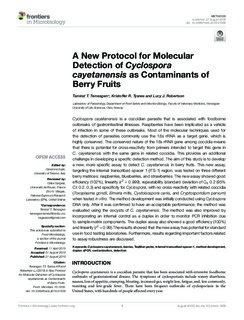| dc.contributor.author | Temesgen, Tamirat Tefera | |
| dc.contributor.author | Tysnes, Kristoffer | |
| dc.contributor.author | Robertson, Lucy | |
| dc.date.accessioned | 2019-10-08T07:50:58Z | |
| dc.date.available | 2019-10-08T07:50:58Z | |
| dc.date.created | 2019-09-26T18:04:17Z | |
| dc.date.issued | 2019 | |
| dc.identifier.citation | Frontiers in Microbiology, 2019, 10 | nb_NO |
| dc.identifier.issn | 1664-302X | |
| dc.identifier.uri | http://hdl.handle.net/11250/2620753 | |
| dc.description.abstract | Cyclospora cayetanensis is a coccidian parasite that is associated with foodborne outbreaks of gastrointestinal illnesses. Raspberries have been implicated as a vehicle of infection in some of these outbreaks. Most of the molecular techniques used for the detection of parasites commonly use the 18s rRNA as a target gene, which is highly conserved. The conserved nature of the 18s rRNA gene among coccidia means that there is potential for cross-reactivity from primers intended to target this gene in C. cayetanensis with the same gene in related coccidia. This provides an additional challenge in developing a specific detection method. The aim of this study is to develop a new, more specific assay to detect C. cayetanensis in berry fruits. This new assay, targeting the internal transcribed spacer 1 (ITS-1) region, was tested on three different berry matrices: raspberries, blueberries, and strawberries. The new assay showed good efficiency (102%), linearity (r2 = 0.999), repeatability (standard deviation of Cq 0.2 (95% CI: 0.2, 0.3) and specificity for Cyclospora, with no cross-reactivity with related coccidia (Toxoplasma gondii, Eimeria mitis, Cystoisospora canis, and Cryptosporidium parvum) when tested in vitro. The method development was initially conducted using Cyclospora DNA only. After it was confirmed to have an acceptable performance, the method was evaluated using the oocysts of C. cayetanensis. The method was also improved by incorporating an internal control as a duplex in order to monitor PCR inhibition due to sample matrix components. The duplex assay also showed a good efficiency (100%) and linearity (r2 = 0.99). The results showed that the new assay has potential for standard use in food testing laboratories. Furthermore, results regarding important factors related to assay robustness are discussed. | nb_NO |
| dc.language.iso | eng | nb_NO |
| dc.rights | Attribution-NonCommercial-NoDerivatives 4.0 Internasjonal | * |
| dc.rights.uri | http://creativecommons.org/licenses/by-nc-nd/4.0/deed.no | * |
| dc.title | A New Protocol for Molecular Detection of Cyclospora cayetanensis as Contaminants of Berry Fruits | nb_NO |
| dc.type | Journal article | nb_NO |
| dc.type | Peer reviewed | nb_NO |
| dc.description.version | publishedVersion | nb_NO |
| dc.source.volume | 10 | nb_NO |
| dc.source.journal | Frontiers in Microbiology | nb_NO |
| dc.identifier.doi | 10.3389/fmicb.2019.01939 | |
| dc.identifier.cristin | 1729855 | |
| dc.relation.project | Norges forskningsråd: 267430 | nb_NO |
| cristin.unitcode | 192,16,2,0 | |
| cristin.unitname | Institutt for mattrygghet og infeksjonsbiologi | |
| cristin.ispublished | true | |
| cristin.fulltext | original | |
| cristin.qualitycode | 2 | |

